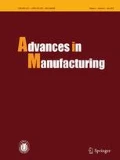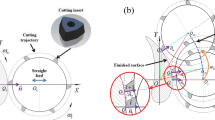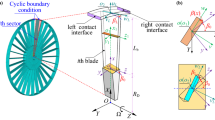Abstract
Whirling has been adopted for the cost-effective machining of blade-shape components in addition to traditional end milling and flank milling processes. To satisfy the requirements of rotary forming in the blade whirling process, the workpiece must be clamped at both ends in suspension and rotated slowly during machining, which complicates the dynamics. This study aims to identify the dynamic characteristics within the blade whirling operation and present strategies for stability prediction. In this study, the dynamic characteristics of a whirling system are modeled by assuming symmetric and asymmetric parameters. Theoretical prediction frequency response function (FRF) results are compared with experimental results. Moreover, semi-discretization stability lobe diagrams (SLDs) obtained using the dynamic parameters of these models are investigated experimentally. The results show that the asymmetric model is more suitable for describing the whirling system, whereas the symmetric model presents limitations associated with the frequency range and location of measuring points. Finally, a set of airfoil propeller blade whirling operations is conducted to verify the prediction accuracy.










Similar content being viewed by others
References
Altintas Y, Tuysuz O, Habibi M et al (2018) Virtual compensation of deflection errors in ball end milling of flexible blades. CIRP Ann 67:365–368
Boulila A, Boujelbene M, Fekiri C et al (2019) Optimization of manufacturing complex-shaped gas turbine blades. Measurement 135:768–781
Li ZL, Zhu LM (2019) Compensation of deformation errors in five-axis flank milling of thin-walled parts via tool path optimization. Precis Eng 55:77–87
Zhao ZC, Fu YC, Liu X et al (2017) Measurement-based geometric reconstruction for milling turbine blade using free-form deformation. Measurement 101:19–27
Vessaz C, Tournier C, Munch C et al (2013) Design optimization of a 2D blade by means of milling tool path. CIRP J Manuf Sci Technol 6(3):157–166
Serizawa M, Matsumura T (2016) Control of helical blade machining in whirling. Proc Manuf 5:417–426
Yi J, Wang XB, Jiao L et al (2019) Research on deformation law and mechanism for milling micro thin wall with mixed boundaries of titanium alloy in mesoscale. Thin-Walled Struct 144:106329
Yang Y, Zhang WH, Ma YC et al (2016) Chatter prediction for the peripheral milling of thin-walled workpieces with curved surfaces. Int J Mach Tools Manuf 109:36–48
Wang XJ, Song QH, Liu ZQ (2021) Dynamic model and stability prediction of thin-walled component milling with multi-modes coupling effect. J Mater Process Technol 288:116869
Ren S, Long XH, Meng G (2018) Dynamics and stability of milling thin walled pocket structure. J Sound Vib 429:325–347
Zhang Z, Li HG, Liu XB et al (2018) Chatter mitigation for the milling of thin-walled workpiece. Int J Mech Sci 138–139:262–271
Dun YC, Zhu LD, Wang SH (2020) Multi-modal method for chatter stability prediction and control in milling of thin-walled workpiece. Appl Math Model 80:602–624
Nam S, Hayasaka T, Jung H et al (2020) Proposal of novel chatter stability indices of spindle speed variation based on its chatter growth characteristics. Precis Eng 62:121–133
Koenigsberger F, Tlusty J (1967) Machine tool structure–vol. I: stability against chatter. Pergamon Press, Oxford
Tobias SA, Fishwick W (1958) Theory of regenerative machine tool chatter. Engineer 205(199–203):238–239
Balachandran B, Zhao MX (2000) A mechanics based model for study of dynamics of milling operations. Meccanica 35(2):89–109
Balachandran B, Gilsinn D (2005) Nonlinear oscillations of milling. Math Comput Model Dyn Syst 11:273–290
Balachandran B, Kalmár-Nagy T, Gilsinn D (2009) Delay differential equations: recent advances and new directions. Springer, New York
Altintas Y, Stepan G, Merdol D et al (2008) Chatter stability of milling in frequency and discrete time domain. CIRP J Manuf Sci Technol 1:35–44
Insperger T, Stépán G (2004) Updated semi-discretization method for periodic delay-differential equations with discrete delay. Int J Numer Methods Eng 61:117–141
Yue CX, Gao HN, Liu XL et al (2019) A review of chatter vibration research in milling. Chin J Aeronaut 32(2):215–242
Yang WA, Huang C, Cai XL et al (2020) Effective and fast prediction of milling stability using a precise integration-based third-order full-discretization method. Int J Adv Manuf Technol 106:4477–4498
Insperger T, Stépán G (2011) Semi-discretization for time-delayed systems: stability and engineering application. Springer, Berlin
Grossi N, Sallese L, Montevecchi F et al (2016) Speed-varying machine tool dynamics identification through chatter detection and receptance coupling. Proc CIRP 55:77–82
Özşahin O, Özgüven HN, Budak E (2010) Analysis and compensation of mass loading effect of accelerometers on tool point FRF measurements for chatter stability predictions. Int J Mach Tools Manuf 50:585–589
Budak E, Tunç LT, Alan S et al (2012) Prediction of workpiece dynamics and its effects on chatter stability in milling. CIRP Ann Manuf Technol 61:339–342
Sultan C (2010) Proportional damping approximation using the energy gain and simultaneous perturbation stochastic approximation. Mech Syst Signal Process 24:2210–2224
Hajdu D, Insperger T, Stepan G (2015) The effect of non-symmemetric FRF on machining: a case study. V006T10A062
Reith MJ, Stepan G (2017) Effect of non-proportional damping on the dynamics and stability of multi-cutter turning systems. Int J Mach Tools Manuf 117:23–30
Kerschen G, Worden K, Vakakis AF et al (2006) Past, present and future of nonlinear system identification in structural dynamics. Mech Syst Signal Process 20(3):505–592
Ewins DJ (2000) Modal testing: theory, practice and application, 2nd edn. Research Studies Press, Baldock
Han LY, Liu RL, Liu XF et al (2020) Theoretical modeling and chatter prediction for the whirling process of airfoil blades with consideration of asymmetric FRF and material removal. Int J Adv Manuf Technol 106:2613–2628
Zhao ZC, Xu JH, Fu YC et al (2017) An investigation on adaptively machining the leading and tailing edges of an SPF/DB titanium hollow blade using free-form deformation. Chin J Aeronaut 31(1):178–186
Huang T, Zhang XM, Ding H (2017) Tool orientation optimization for reduction of vibration and deformation in ball-end milling of thin-walled impeller blades. Procedia CIRP 58:210–215
Totis G, Insperger T, Sortino M et al (2019) Symmetry breaking in milling dynamics. Int J Mach Tools Manuf 139:37–59
Acknowledgements
The authors sincerely acknowledge the Shandong Provincial Natural Science Foundation, China (Grant. No. ZR2017MEE021) for the financial support toward this research.
Author information
Authors and Affiliations
Corresponding author
Rights and permissions
About this article
Cite this article
Han, LY., Liu, RL. & Liu, XF. Modal parameter determination and chatter prediction for blade whirling: a comparative study based on symmetric and asymmetric FRF. Adv. Manuf. 9, 145–159 (2021). https://doi.org/10.1007/s40436-020-00337-8
Received:
Revised:
Accepted:
Published:
Issue Date:
DOI: https://doi.org/10.1007/s40436-020-00337-8




